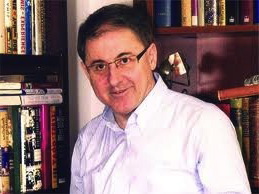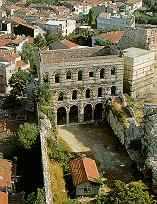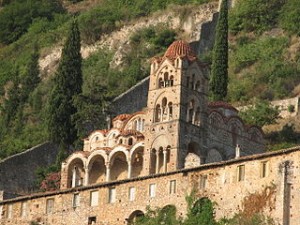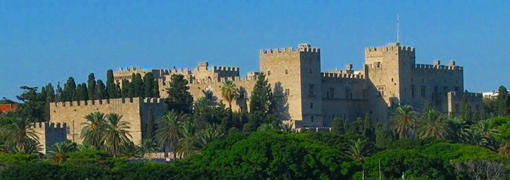When the novel’s speaker brings a framed picture to a meeting with a mysterious messenger, as requested, his life changes forever. “This,” the messenger announces, “is an engraving of the last Byzantine emperor, Constantine Dragas Palaeologus XI [who died in exile in 1475]…and you, sir, are his last descendant, which is to say, you are the current Byzantine emperor-in-exile, Constantine Palaeologus XV.”
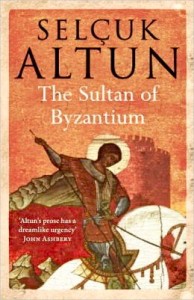 When the son of Paul Hackett, an American, hears these words, he is stunned, unable to imagine how these circumstances have evolved. He has lived with his mother’s family in Turkey ever since his parents divorced when he was two, and he has shared the name of his Turkish grandfather, ever since. Telling his own story, the speaker is now a successful businessman in his early thirties, and an associate professor who teaches two days a week at Bosphorus University. An economist schooled at Columbia in New York and at the London School of Economics, he loves research and writing, and he is intrigued by the prospect of investigating the baffling announcement that he is truly the latest emperor-in-exile. Long fascinated by the history of the Byzantine Empire, which lasted for over eleven hundred years before being finally defeated by the Ottoman Turks in 1453, the speaker is anxious to investigate further.
When the son of Paul Hackett, an American, hears these words, he is stunned, unable to imagine how these circumstances have evolved. He has lived with his mother’s family in Turkey ever since his parents divorced when he was two, and he has shared the name of his Turkish grandfather, ever since. Telling his own story, the speaker is now a successful businessman in his early thirties, and an associate professor who teaches two days a week at Bosphorus University. An economist schooled at Columbia in New York and at the London School of Economics, he loves research and writing, and he is intrigued by the prospect of investigating the baffling announcement that he is truly the latest emperor-in-exile. Long fascinated by the history of the Byzantine Empire, which lasted for over eleven hundred years before being finally defeated by the Ottoman Turks in 1453, the speaker is anxious to investigate further.
A secret organization known as Nomophylax (Guardians of the Law) has been guarding Constantine XI’s fortune for the more than five hundred years since his death in exile in 1475, and they have secretly kept the throne-in-exile alive and occupied.
“They never failed to increase the fortune they had inherited, never cut corners and never took risks. Nobody knows how many billion dollars the Nomo balance sheet is worth these days.” The will belonging to the speaker’s grandfather was also left with Nomo, attesting to the connection between the speaker and the organization. Nomo representatives then reveal the whole story to the speaker, announcing: “The moment you take your oath accepting the honor and obligations of the imperial crown, you will be assigned a special mission,” he is told. “When this mission is accomplished, it will mean that a very significant trial has been passed. It is then that you, together with the members of Nomo, will decide the future of the organization.”
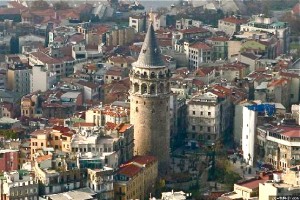
The speaker looks out his window at the Galata Tower and comments on the maze of streets surrounding it.
As soon as the representatives from Nomo explain his mission, the speaker immediately leaves his job and begins serious study at the Center for Research in Byzantine History at Chatham House in London, before going to Dumbarton Oaks in Washington, DC, to study at their library in Byzantine Studies. He also goes to the University of Virginia, where he tries to find out more information about his father, a graduate of the law school there, eventually meeting some Hackett family members on the West Coast. (In a humorous aside, he is aided by a private detective, Kinsey Milhone, a name well known to readers of mystery stories.) His nearly full-time travels then begin in earnest. On his return to Istanbul, he visits the Tekfur Palace, the crumbling remains of the palace once occupied by his emperor ancestor, and it is at a meeting nearby that he is finally given a box for which he must find the six tiles that fit into special slots and are the key to his quest. Subsequently, he visits, among other places, the Antioch Museum; then Athens, where he sees a statue of Constantine XI; and the Greek city of Mistra, near Sparta. Continuing on, he goes to Venice and Cappadocia in Italy, then to Nice, Seville, Lausanne, Hamburg, Nantes, and Liege. The travels seem never-ending, though he manages occasionally to visit a woman to whom he is seriously attracted in Stockholm, before leaving again for other places, like Sao Paolo, or Lindos on Rhodes.
This unusual novel defies genre. The story as described above, resembles a fantasy, providing a framework for this novel, but it represents only a small part of the actual text. The novel is also a “quest story.” The speaker is given tasks, in this case finding six tiles to fit into a special box, and as is typical of quests, he travels throughout the world searching for these tiles. The fact that he finds them more by chance than through his own efforts suggests that Turkish author Selcuk Altun has created this search primarily to allow the speaker to travel to a variety of well-described places important to Byzantine history, rather than to emphasize the plot itself.
The speaker’s travels, typical of a quest, do not involve hardship, financial or otherwise, and this is not a travel narrative in which a main character faces dangerous obstacles as he travels to exotic places around the globe. Here the travels are to places well known to historians and tourists who have traveled through Turkey, Greece, the eastern Mediterranean, and Europe. The author provides insights into the Byzantine history associated with these places as the speaker travels, a pattern which slows down the narrative for those who are primarily interested in the quest and fantasy aspects of the novel, but which will intrigue many readers unfamiliar with this background.
Author Selcuk Altun is a “friend” of the novel’s speaker, as we discover through references to him throughout the novel, and it is clear that Altun is obsessed with Byzantine history and thrilled to use the novel to provide little known information to readers. Detailed information about the order of the emperors and how they ascended to their thrones, the people they killed and maimed, and how they themselves died sometimes make the novel feel more like a history book than a novel. The term “Byzantine intrigue” takes on new meaning as the stories of the emperors unfold.
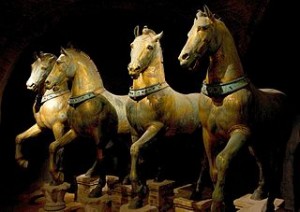
The speaker would like to return these four horses to Constantinople from Venice. They were plundered during the sack of Constantinople in 1204.
By the time the speaker’s quest ends, the reader will have been treated to a panoramic view of Byzantine history and some of the empire’s contributions throughout the world over the eleven hundred years of its existence. The story of the quest keeps the reader occupied during the slower, historical parts of the narrative, while the travels will intrigue many readers who may have traveled to these sites. At the same time they may inspire the reader who has not traveled to these places to visit them, either in person or on-line. For those curious about Byzantium, the “heir to the civilizations of Greece and Rome,” this novel is an unusual, non-traditional novel about its history and on-going influence. The author himself concludes, “If humans ever offer prayers of gratitude for the gifts they have received, the name of Byzantium ought to come after God and before Jesus.”
ARC: M. Zegarek PR
Photos, in order: The author’s photo is from http://oklapkutuphanesi.blogspot.com
Galata Tower, with its maze of streets, appears on http://members.virtualtourist.com and was posted by Santini738:
The Tekfur Palace appears on http://www.atamanhotel.com/tekfur.html
Mistra is from http://commons.wikimedia.org and was posted by Ed88
The Four Horses on San Marco are shown here: http://en.wikipedia.org These are the originals, now in a museum, and copies appear on the facade of San Marco.
The Palace of the Grand Master is from http://travelsort.com
ARC: M. Zegarek PR
